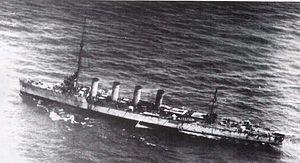 Novara, after the Battle of the Otranto Straits
| |
| Class overview | |
|---|---|
| Name | Novara class |
| Builders | |
| Operators | |
| Preceded by | Admiral Spaun |
| Built | 1911–1915 |
| In service | 1914–1941 |
| In commission | 1914–1937 |
| Completed | 3 |
| Scrapped | 3 |
| General characteristics | |
| Type | Scout cruiser |
| Displacement | |
| Length | 130.6 m (428 ft 6 in) o/a |
| Beam | 12.77 m (41 ft 11 in) |
| Draught | 4.95–5.3 m (16 ft 3 in – 17 ft 5 in) |
| Installed power |
|
| Propulsion | 2 shafts; 2 × steam turbines |
| Speed | 27 knots (50 km/h; 31 mph) |
| Range | 1,600 nautical miles (3,000 km; 1,800 mi) at 24 knots (44 km/h; 28 mph) |
| Complement | 340 |
| Armament |
|
| Armor |
|
The Novara class (sometimes called the Helgoland class[1] or the Admiral Spaun class[2][a]) was a class of three scout cruisers built for the Austro-Hungarian Navy. Named for the Battle of Novara, the class comprised SMS Saida, SMS Helgoland, and SMS Novara. Construction started on the ships shortly before World War I; Saida and Helgoland were both laid down in 1911, Novara followed in 1912. Two of the three warships were built in the Ganz-Danubius shipyard in Fiume; Saida was built in the Cantiere Navale Triestino shipyard in Monfalcone. The Novara-class ships hold the distinction for being the last cruisers constructed by the Austro-Hungarian Navy.
Saida and Helgoland were commissioned into the fleet in the opening weeks of World War I, in August and September 1914, respectively. Novara followed in January 1915. All three ships saw limited action during the first year of the war, and following Italy's declaration of war on Austria-Hungary in May 1915, the ships participated in a bombardment of the Italian coastline. Throughout the rest of 1915, the Novara-class cruisers engaged in various operations across the Adriatic Sea and the Strait of Otranto.
All of the Novaras were assigned to the First Torpedo Flotilla of the Austro-Hungarian Navy upon their commissioning, with Saida named the flotilla leader. and were initially stationed out of the naval base at Sebenico, before eventually being deployed to Cattaro. Throughout the rest of 1915 and 1916, all three ships saw extensive combat in several raids directed at the Otranto Barrage which prohibited the bulk of the Austro-Hungarian Navy from leaving the Adriatic Sea. These actions culminated in the Battle of the Strait of Otranto in May 1917, where the Novaras participated in the largest surface engagement of the Adriatic Campaign of World War I. The ensuing battle resulted in an Austro-Hungarian victory, though Novara suffered damage.
Emboldened by this operation and determined to break the Otranto Barrage with a major attack on the strait, Austria-Hungary's newly appointed Commander-in-Chief of the Fleet (German: Flottenkommandant) Miklós Horthy de Nagybánya organized a massive attack on the Allied forces with the three Novara-class cruisers, alongside seven battleships, one cruiser, four destroyers, four torpedo boats, and numerous submarines and aircraft, but the operation was abandoned after the battleship Szent István was sunk by the motor torpedo boat MAS-15 on the morning of 10 June.
After the sinking of Szent István, the ships returned to port where they remained for the rest of the war. When Austria-Hungary was facing defeat in October 1918, the Austrian government transferred its navy to the newly formed State of Slovenes, Croats and Serbs in order to avoid having to hand the ship over to the Allies. Following the Armistice of Villa Giusti in November 1918, the Novara-class cruisers were divided between Italy and France, with Saida and Helgoland both being ceded to the Italians before being renamed Venezia and Brindisi respectively, while Novara was handed over to France and renamed Thionville. The Novara-class cruisers were the largest ships of Austro-Hungarian Navy to serve under the flag of another nation after the war, having been transferred to the victors.[3] After serving in the Italian Regia Marina for 17 years, Venezia and Brindisi were sold for scrap in March 1937; Thionville was decommissioned from the French Navy in 1932 and broken up for scrap in 1941.
- ^ Gill 1922, p. 1988.
- ^ Gardiner & Gray 1985, p. 336.
- ^ Sondhaus 1994, p. 363.
Cite error: There are <ref group=lower-alpha> tags or {{efn}} templates on this page, but the references will not show without a {{reflist|group=lower-alpha}} template or {{notelist}} template (see the help page).